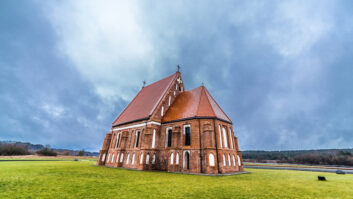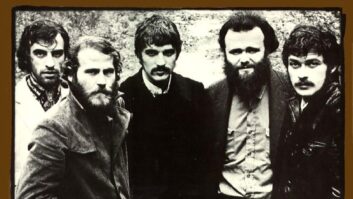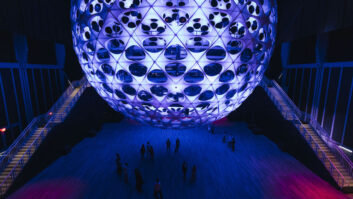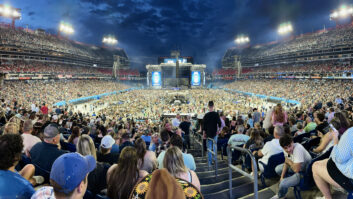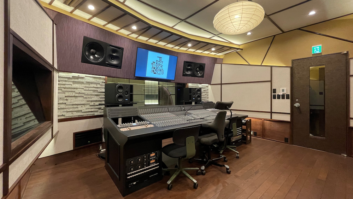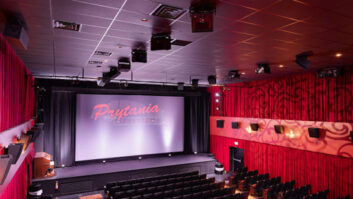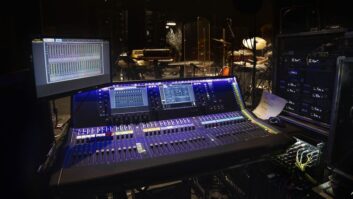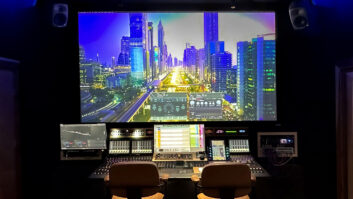Electronic music is just a different beast altogether. Generally, anything that falls under the headings electronic or industrial is seen as the obsessive effort of a dark figure, locked away from the world performing unspeakable acts on otherwise innocent computers.
In actual fact, the current nature of electronic music allows bandmembers to exchange audio files easily, with the freedom to work on their own and at their pace: “We don’t jam; there’s no jamming whatsoever,” insists MDFMK co-founder Sausha Konietzko. “It’s really annoying to me when someone tries to get a guitar riff down. I prefer that Tim [Skold, the group’s co-founder] does that by himself and vice versa. He’s not interested in listening to me check out different compressor settings for like three hours. It’s a waste of our time.”
On the heels of the 1999 breakup of KMFDM (arguably one of the premier techno/industrial crossover acts of the ’90s), the core songwriting team of Konietzko and Skold regrouped and launched their new enterprise, MDFMK-with vocalist Lucia Cifarelli later rounding out the lineup. To facilitate their unique songwriting and recording process, Konietzko and Skold built separate but fully compatible home studios for the recording of their self-titled Republic Records debut.
Both studios are centered around identically equipped 350MHz Macintosh 9600s, which include an array of 9-Gig removable Seagate Cheetah hard drives, a Pro Tools|24 MIX Core card, two Pro Tools DSP Farm cards and two Digidesign 888 24-channel I/Os. Tracking and sequencing are done to Emagic Logic Audio 4.0, and Pro Tools 5.0 is reserved for editing. Konietzko explains that the matching computer systems make the exchange of ideas almost effortless. “I would call him [Skold] up and be like, ‘What are you working on?'” he says. “And he would just take his drive and stick it in like a lunch box and pop it in, and it’s right there. If there were any MIDI files, I’d just dial up the program he used and there it was, or say for the Nord, he would record a string of Sysex into the sequencer and I’d just fire up the Nord and, boom, there is his sound. For the most part, though, we would turn everything into audio at a pretty early stage.”
Konietzko and Skold’s Seattle-based studios do differ in some major ways. Konietzko’s room was a custom-built, soundproof addition to his home, boasting both a control room and a small iso booth where a good amount of the vocals on the new album were cut. Skold, on the other hand, approached home recording a little differently: “I’m not totally opposite, but I hate the padded walls. [Laughs] I like the windows. I’m much more into trying to find a good angle in an existing situation, moving my speakers until I’m happy with them as opposed to just going to town with the foam and the padding. Although it goes without saying that Sausha’s room sounds better than mine.”
The new album was assembled by both tracking to Logic and through computer-based sound sculpting and editing where countless fragments and odd elements were refined, processed, tweaked and pieced together. The band’s endless list of hardware and software synths, stomp boxes and outboard gear provided much of the Pro Tools fodder-some of their favorites included Propellerheads Rebirth 2.0, Jomox Air-Base, Akai S3000XL, Roland SH-101, Art MP-1 and the Manley Variable-MU. Guitars and bass were recorded dry, directly into Pro Tools, processed through Line 6’s Amp Farm and sent to the Pro Tools “chopping block.” “The curse of the hard disk re-corder,” Skold muses. “Some of the stuff was played at different times, different days, different frames of mind, different tunings, and through editing, becomes one riff.”
The final stage of the recording process involved taking the finished tracks over to Studio X in Seattle for mixing and overdubbing vocals. The move to a larger facility, according to Konietzko, was done mainly to keep a fresh perspective on things and give the band a little more room to move around.
“It might be mental,” Skold adds. “But I know I perform a shitload better vocally, if I’m standing in a booth, with a pop screen, and I know this room is costing me a grand and a half every day, and I better f-ing sing. But on the other hand, my guitar playing goes totally in the opposite. It’s a double-sided sword.”
Following the completion of the album, Konietzko and Skold left Seattle after living in the city for more than five years and set up new digs in New York and Los Angeles, respectively. Presently, a pair of CD burners and a hefty FedEx bill are helping them keep the ideas flowing, although T1 connections and file sharing over the Net are in the works.
